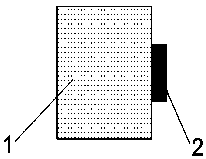Detection method of holding force of vitrified-bond corundum abrasive tool
A vitrified bond and detection method technology, applied in the field of abrasives and abrasive tools, can solve the problem that the holding force cannot be directly measured, and achieve the effect of easy operation and accurate measurement results
- Summary
- Abstract
- Description
- Claims
- Application Information
AI Technical Summary
Problems solved by technology
Method used
Image
Examples
Embodiment 1
[0024] a. Assemble the mold and put in 15 grams of Al 2 O 3 -Na 2 O-B 2 O 3 -SiO 2 The basic ceramic bond is pressed into a ceramic bond block under a pressure of 40Mpa.
[0025] b. Place a single corundum abrasive grain with a particle size of 0.1 mm in the middle of the binder block in step a.
[0026] c. Put the above sample in a muffle furnace for curing, that is, heat up from room temperature to 250°C at a heating rate of 5°C / min and keep it for 1 hour, and heat up to 250°C and keep it warm at a heating rate of 4.5°C / min For 2 hours, the temperature was increased to 720°C at a temperature increase rate of 5.5°C / min, and the temperature was kept for 2.5 hours, and then cooled to room temperature to obtain a ceramic bond corundum sample block.
[0027] d. Grind and polish the above samples.
[0028] e. Fix the above sample on the desktop, and the section with the smallest bond block area is vertical to the desktop, that is, the sequence in the field of view is bond-abrasive particl...
Embodiment 2
[0031] a. Assemble the mold and put in 15 grams of Al 2 O 3 -Na 2 O-B 2 O 3 -SiO 2 The basic ceramic bond is pressed into a ceramic bond block under a pressure of 40Mpa.
[0032] b. Place a single corundum abrasive grain with a particle size of 0.2 mm in the middle of the binder block in step a.
[0033] c. Put the above sample in a muffle furnace for curing, that is, heat up from room temperature to 250°C at a heating rate of 5°C / min and keep it for 1 hour, and heat up to 250°C and keep it warm at a heating rate of 4.5°C / min For 2 hours, the temperature was increased to 720°C at a temperature increase rate of 5.5°C / min, and the temperature was kept for 2.5 hours, and then cooled to room temperature to obtain a ceramic bond corundum sample block.
[0034] d. Grind and polish the above samples.
[0035] e. Fix the above sample on the desktop, and the section with the smallest bond block area is vertical to the desktop, that is, the sequence in the field of view is bond-abrasive particl...
Embodiment 3
[0038] a. Assemble the mold and put in 15 grams of Al 2 O 3 -Na 2 O-B 2 O 3 -SiO 2 The basic ceramic bond is pressed into a ceramic bond block under a pressure of 40Mpa.
[0039] b. Place a single corundum abrasive grain with a particle size of 0.3 mm in the middle of the binder block in step a.
[0040] c. Put the above sample in a muffle furnace for curing, that is, heat up from room temperature to 250°C at a heating rate of 5°C / min and keep it for 1 hour, and heat up to 250°C and keep it warm at a heating rate of 4.5°C / min For 2 hours, the temperature was increased to 720°C at a temperature increase rate of 5.5°C / min, and the temperature was kept for 2.5 hours, and then cooled to room temperature to obtain a ceramic bond corundum sample block.
[0041] d. Grind and polish the above samples.
[0042] e. Fix the above sample on the desktop, and the section with the smallest bond block area is vertical to the desktop, that is, the sequence in the field of view is bond-abrasive particl...
PUM
| Property | Measurement | Unit |
|---|---|---|
| Particle size | aaaaa | aaaaa |
| Particle size | aaaaa | aaaaa |
| Particle size | aaaaa | aaaaa |
Abstract
Description
Claims
Application Information
 Login to View More
Login to View More - R&D
- Intellectual Property
- Life Sciences
- Materials
- Tech Scout
- Unparalleled Data Quality
- Higher Quality Content
- 60% Fewer Hallucinations
Browse by: Latest US Patents, China's latest patents, Technical Efficacy Thesaurus, Application Domain, Technology Topic, Popular Technical Reports.
© 2025 PatSnap. All rights reserved.Legal|Privacy policy|Modern Slavery Act Transparency Statement|Sitemap|About US| Contact US: help@patsnap.com

